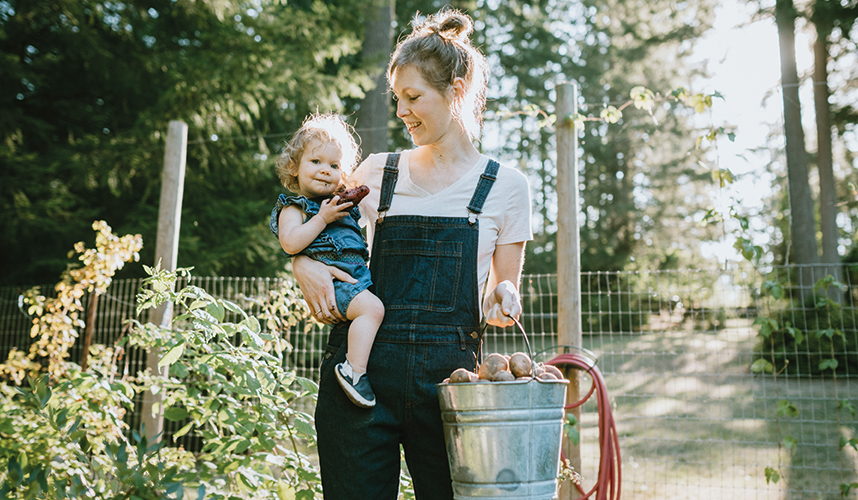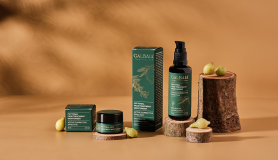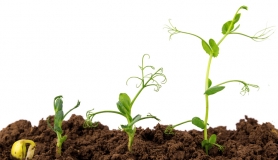Maybe you are faced with a large area of weeds - and yet you don’t want to use toxic chemical weedkillers.
One of the main reasons we give up growing vegetables is because we run out of time and energy by trying to cultivate the whole plot straight away. Here’s an energy efficient guide to getting started. In just a few hours a week, you will enjoy producing cost effective, delicious fruit and veg. All done the organic way.
PREPARING THE PLOT
If your vegetable growing area is thick with weeds and overgrown with grass, don’t try clear it all before planting. Hours of digging will only lead to back ache and the depressing sight of weeds returning. Instead, divide the plot in half. Dig one half, and cover the other half with a thick organic mulch. It’s a win win decision! In half the time you’ll have prepared the plot, as well as making it more productive. Here’s how to do it.
- For the mulched half, cut down the larger weed foliage to just above soil level using a satisfying slash technique (much of the foliage goes on your new compost heap, so long as it has no seeds within). Then cover the area with a mulch that will exclude light. You can use a variety of materials to do this – a thick (20 cm) layer of compost or manure is ideal, topped by cardboard (add another layer of manure so it doesn’t blow away), or a black plastic membrane, pinned down. (Don’t use carpet – many of the dyes have toxic chemicals that can leach into your precious soil.) If you don’t have a suitable sheet covering, then a deep layer of mulch does just as well in excluding the light and suppressing weeds. Use homemade compost, fully-rotted manure, leaves, straw, grass mowings – or even a mix of them all, so long as it is more than 15 cm thick. Eventually it will rot down and create a wonderful, friable soil texture which is not only rich but allows weed roots, such as bindweed, to be pulled out easily.
- Leave this for at least 6 - 12 months. It’s that simple. You don’t have to do a thing, as the weeds will weaken in the dark and the earthworms do their work to enrich the soil.
- Now you only have half a plot to dig. Make sure you get out all the roots of the weeds. Compost their foliage, and drown the roots in a bucket of water for 2 months, before adding them to the compost heap. Turn a layer of compost into the first 5 – 10 cms of the soil and you are ready to plant or sow.
Planning your crops
Let’s assume you can’t work in your garden all day, every day. With only a few growing hours a week, you want to make sure that what you grow is what you want to eat. If you can easily buy organic potatoes and carrots, we recommend you don’t waste time on such cheap items. Go instead for luxury crops – strawberries, raspberries and asparagus. Many are easier to grow than carrots, and considerably more expensive to buy organic.
Similarly, herbs are easy to grow and you will have generous quantities to use, unlike the expensive small supermarket bunches. Kale, a popular and probably overpriced vegetable, is very easy to grow – and keeps you in green veg throughout the winter.
If you plant a fruit tree, make sure it is a variety not usually found in supermarkets – and from an organic nursery. Why grow Golden Delicious when you can have a juicy Beauty of Bath, or Conference pears when you can have creamy Beurre Hardy?
WHY NO DIG?
The No Dig method of cultivation can be used for two purposes: to provide a rich soil to grow in, and to clear a weed-infested growing area. Both instances require a great deal of surface mulch (well-rotted manure or compost). In principle, by avoiding digging you will not be disrupting the soil life, nor will you be exposing the soil to weed seeds. Instead the existing weeds are in darkness, which causes them to weaken and die.
For soil that is already cultivated:
- Apply at least 15 cm or more of an organic, well decomposed mulch to your beds. You don’t need to dig beforehand, as soil organisms such as worms will rise to the mulch, eat and digest it, creating a rich and well textured soil.
- You can plant or sow direct into the surface compost of newly-created beds, just as you would normally. You will find there are less weeds to hoe, they are easy to deal with in the soft surface, and the soil beneath is firm but not compacted, as the undisturbed soil organisms develop a honeycomb of small air passages – perfect for plant root penetration. To sow seeds, use a rake to prepare a soft, crumbly tilth on the surface.
- Use a trowel to remove any weed regrowth through mulches. Annual weeds will die within 2 to 3 months; but perennials take longer – often up to a year. Only bindweed and marestail can survive, but they become noticeably weaker. And as the soil becomes more friable and richer, it is easier to pull out the long root systems in bindweed, for instance.
- Ongoing maintenance involves annual applications of just 5 cm or so of compost or manure. This should be applied ideally in the autumn, when crops are cleared, or in spring on beds where winter crops have been growing.
Pest free gardening
Chemical weedkillers are toxic. They are often created as a mix of glyphosate and toxic surfactants which attack the plant and can create a residue in the soil. They are skin and eye irritants, and some research has shown them to be potentially carcinogenic. As well as being poisonous to the weed, glyphosate formulations in the soil can inhibit the root uptake of nutrients – causing a crop to struggle more.
Pesticides will kill indiscriminately. Although sprays are aimed at aphids or other pests, they also kill other harmless insects. Worse than that, many of these insects are of great use to the grower. Ladybirds and hoverflies will not only eat the aphids, but also help bees and butterflies as pollinators. Pesticides can also create a health hazard for birds or frogs.
Slugs! Tempting though it is to scatter pellets around the baby lettuce plants, there are other ways to deter slugs and snails. Protection of vulnerable plants is the key. And don’t rely on only one method. Always renew barriers after rain, and accept that some damage is inevitable.
The following may help: dig to disrupt both slug and its eggs; encourage natural controls such beetles, frogs, birds and hedgehogs; frequently inspect your plants and hand pick off (particularly in damp weather and at night); create barriers of dry material which slugs find hard to traverse, such as grit – and renew after rain. If you use traps (ie, beer in a container), empty them frequently. To avoid killing ground beetles, which eat the slugs, it is better to put your beer into a saucer with raised edges. Use of nemotodes (microscopic organisms, available to buy online) can have some success, but they only work once in a season, and the conditions are very specific for the nemotodes to function. Iron phosphate pellets, sold as organic pellets, should only be used when absolutely necessary, and sparingly.
MORE INSPIRATION
VISIT gardenorganic.org.uk for advice and to share tips with other gardeners
READ Organic Gardening: The Natural No-dig Way By Charles Dowding







